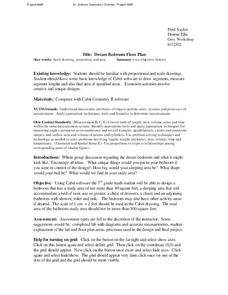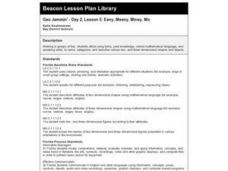Curated OER
Dream Bedroom Floor Plan
Students build and apply concepts of geometry. For this geometry lesson, students create a building using proportions and scale drawings. They use Cabri technology to create a virtual drawing first.
Curated OER
Dream Bedroom Floor Plan
Students construct using Cabri software. In this geometry lesson, students convert between units and apply the correct measurements to build objects. They create the room virtually and manipulate the shapes to the desired measurements.
Curated OER
Non-Poisonous Snake
In this snake activity, students read the description of the snake and its cage and choose the cage shape and finish the picture of the snake. Students complete 2 activities.
Curated OER
Seasonal CEENBoT
Students simulate the Earth's revolution around the sun using CEENBoT. In this earth science lesson students calculate the Earth's distance in AU and it's speed of revolution. They explain how the Earth's movement cause seasonal variation.
Curated OER
Classifying Polygons
Learners study polygons. In this math lesson, students play a game in which they learn the classification system for polygons. Learners identify the properties of quadrilaterals.
Curated OER
The Anti-Gravity Machine
Students examine physics by completing a bicycle experiment in class. In this gravity lesson, students measure the characteristics of different bicycles and compare their different race times. Students utilize a shoebox, pencil, tape,...
Curated OER
Thought Experiments in Physics
Using thought experiments in physics can be incredibly valuable, but there some pitfalls to avoid.
Curated OER
Plain Figures And Measuring Figures
Seventh graders investigate the mathematical concept of a sector. They apply the concept to an example problem and then move into a more complex application. They find the area of the side of a cone. This is done as students calculate...
Curated OER
Investigating the Idea of Tan
Fifth graders use tan to solve problems involving right-angled triangles. They solve equations of the form tan(8) =a, for a between 180 degrees and 360 degrees. They state the value of tan (8) in special cases.
Curated OER
Parallax
Students discover how astronomers used the diameter of the Earth's orbit around the Sun as a baseline for estimating the distance of some stars, and the meaning of "Parsec" and "light year."
Curated OER
Ovals, Rectangles, Squares, and Triangles
Students identify geometrical shapes displayed in photographs of everyday objects in a metropolitan setting.
Curated OER
Clocks and Time
Learners construct clocks and then learn how to read a clock face, tell time, and determine how much time has elapsed.
Curated OER
Dimensional Flower Garden
Students relate the colors in a garden to those in a rainbow by creating a multicolored three-dimensional garden portrait. They read, "Planting a Rainbow" by Lois Ehlert, then construct their garden with colored paper on white cardstock.
Curated OER
Math: Equal Area Triangles
Young scholars examine a math worksheet and determine how to divide a single triangle into four of equal area. Using geometric principles, they sketch two additional ways to divide into into four equal triangles. To conclude, students...
Curated OER
Exploring Centers of a Triangle: Part 1
Learners use problem solving skills, formal geometry, and The Geometer?s Sketchpad. They model and solve two real-world problems by constructing the in center and circumcenter of triangles.
Curated OER
How Long is a Slinky?
Students take part in a variety of measurement tasks. Students measure the length of a slinky. Students work out how many slices of tomato will fit around the edge of a pizza. Students measure the label from a can accurately.
Curated OER
The Connection Between Pigment and Light Colors
Students learn the procedure for mixing secondary colors from primary pigments and observe the results of mixing two primary colors.
Curated OER
Geo Jammin' - Day 2, Lesson 5: Eeny, Meeny, Miney, Mo
Students, in groups, use song lyrics and math to descrie two and three dimensional shapes.
Curated OER
Pi Digit Distribution
Students study graphing skills and compare and contrast data sets. They compute pi through the first 50-100 digits and create a bar graph showing the frequencies of specific digits.
Curated OER
Copycats
Third graders describe the features of 2 and 3 dimensional objects and use the language of geometry. They design and make a pattern which involves translation, reflection or rotation.
Curated OER
Math Who Am I?
In this math facts review activity, students read the description of each math term and try to guess what the answer is. Students may check their attempts by circling the third letter in the box which gives the answer.
Curated OER
Frog External Anatomy
Sixth graders study frog anatomy. In this frog anatomy instructional activity students examine a frog including the anatomy of its mouth and fill out a worksheet.
Curated OER
The Reason for the Seasons; Science, Geography
Students think about what causes the seasons to change, reflect on what they know about seasons and how their lives affected by seasonal changes.
Curated OER
Prints and Outlines
Students determine the area of two objects by superimposing one on the other. They compare and order the area of different shapes by covering a larger shape with similar smaller ones. They complete these activities as different stations.
Other popular searches
- And Central Angle of Circles
- Central Angles in Circles
- Inscribed Angles in Circles
- Angles in Circles
- Central Angle of Circles
- Central Angles of Circles
- Inscribed Angles of Circles
- Angles Circles
- Angles Circles and Polygons

























